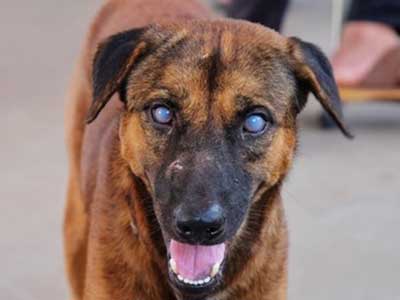Ehrlichia canis update

Caption: E.canis recovered dog with cloudy blue eyes.
The exotic tick borne disease, ehrlichiosis was detected in the Territory in June 2020. The disease is also present in the Kimberly region of Western Australia and APY Lands in South Australia. Surveillance of dogs during 2020 has indicated widespread distribution of the disease across the Territory, particularly in remote communities. It has also been diagnosed in station dogs which have had no known contact with community dogs.
The disease is now established in the brown dog tick population (as distinct from cattle tick) and remains a risk to all dogs, dingoes and foxes in the Northern Territory (NT).
Over 800 samples from NT dogs have been tested for ehrlichiosis at Berrimah Veterinary Laboratory with more than 200 dogs testing positive and many more reports of suspect cases in remote areas.
Signs and symptoms of ehrilichiosis infection in dogs include the following:
- fever
- lethargy
- loss of appetite
- weight loss
- swelling of chest or front legs
- cloudy eyes or conjunctivitis
- pain and stiffness
- bleeding disorders such as nosebleeds or bruising on the gums or belly.
Infection must be treated with antibiotics for the best chance of recovery. Veterinarians have reported up to 25% death rate in dogs presented at the clinics, particularly when bleeding disorders are present. Cloudy blue eyes are a distinct characteristic of recovering dogs.
Ehrlichiosis infection in dogs can be prevented with the use of a combination of strategies. These include:
- having dogs on a tick control program - tick collars and spot-ons are the best primary protection used in combination with tablets and chews registered for tick control
- managing tick infestations in buildings and yard areas
- preventing dogs from entering tick-infested areas
- inspecting dog’s daily for ticks, especially if they have been in tick-infested areas.
A management strategy is being prepared for the long-term management of ehrlichiosis in the Territory which will focus on:
- minimising the impact of ehrlichiosis on dogs
- preventing brown dog tick infestation in housing and the environment
- preventing the risk of ehrlichiosis infection in Territorians.
Caption: NT Map showing E.canis test results.
More information
For more information on ehrlichiosis, take a look at the NT Government website.

